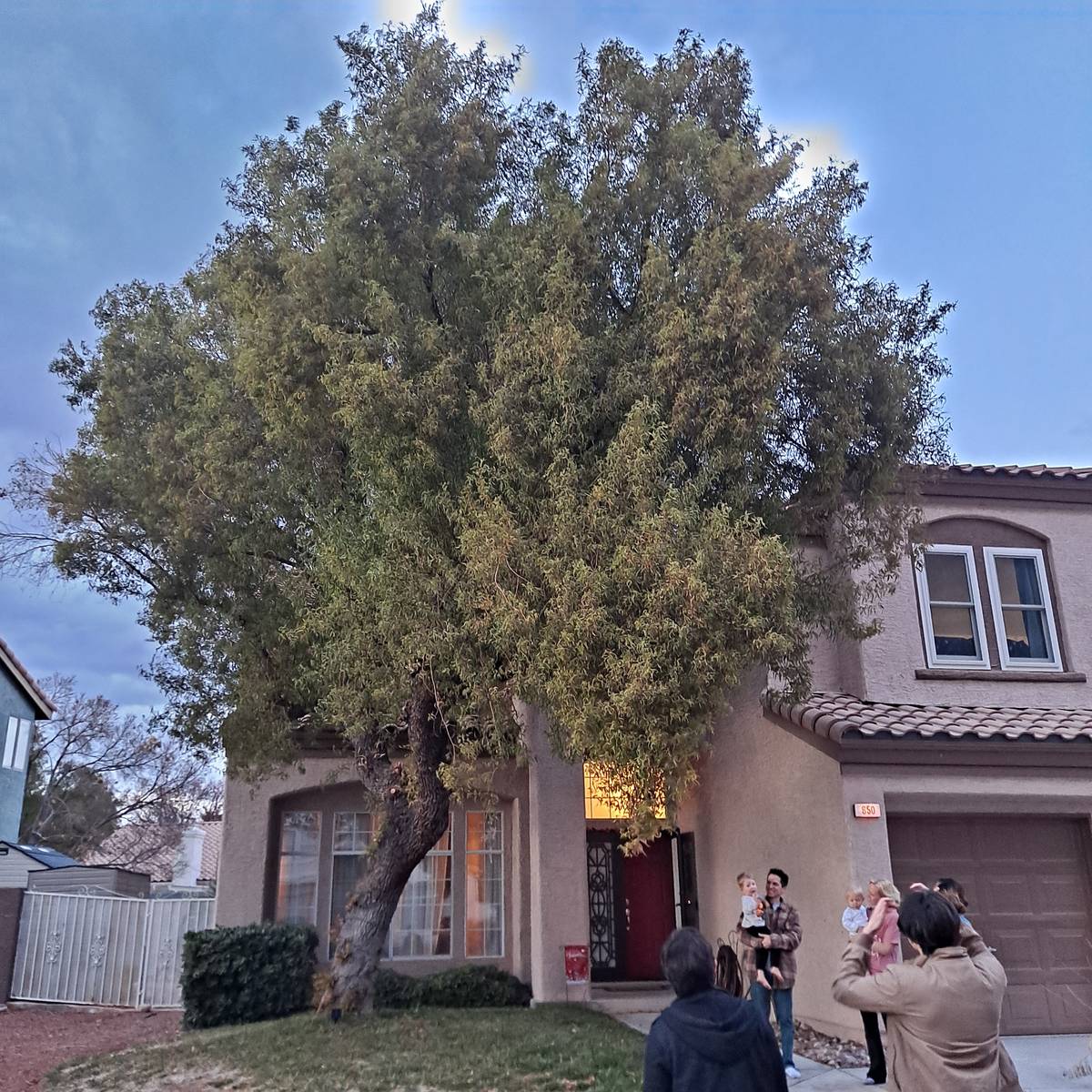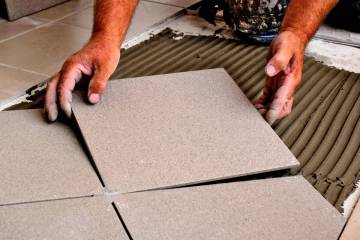African sumac can grow in both grass, rock landscapes
Q: African sumacs in the valley seem to be getting more stressed through the years. The bark begins to peel, and the trunk sheds through the branches. Is this an appropriate tree to plant in the valley? I noticed the less stressed ones are planted in areas not as hot and don’t get full direct sun for most of the day.
A: Good observation. You’re right they will grow better when they are young and on the east or north side of a home and not planted where it is terribly hot.
As far as if it is a good tree for our city, it depends on your perspective. African sumac is considered somewhere between mesic and xeric in its water use. It’s not a true desert tree such as a palo verde or several types of acacia that are considered xeric.
But it can handle both a desert landscape and non-desert as well. It thrives in a lawn (it will get to 40 feet tall, a height similar to a mulberry) or tolerates the rock of a desert landscape where it will stay closer to 30 feet tall. It just likes other plants nearby that require infrequent but deep water as well.
This 30- to 40-foot tree (think two-story house) handles the heat of our desert, but I think most of the problems you’re seeing are because it does not get enough water when it needs it. It can get by with infrequent watering, but when it does get water, it likes it spread out everywhere under its canopy and enough applied to wet the soil 2 to 3 feet deep.
Make sure that there are enough drip emitters near it either watering its roots directly or by planting smaller shrubs near it that need watering as well. This way the soil stays wet.
It’s a messy tree from shedding leaves in the summer, and the female can cause quite a few new plants to grow from seedlings beneath its canopy. And it can sucker from the trunk and lower limbs reflective of its wildfire heritage. But I think the damage you’re seeing is from a lack of water.
Once it starts hitting that 30-foot or so mark it’s going to require about 200 gallons a week. Maybe even 250 to 300.
Q: I have several tiny pine trees that apparently grew from seeds dropped by my older pine trees. They are close to the mature trees, and I want to transplant them. When is the best time of the year to do that here in Las Vegas, and how should I do it?
A: Many pine trees (including Afghan and Mondell pine) develop a strong taproot when they first start growing from seed. All plant seedlings grow the root first (called the radicle), then the top of the plant grows shortly afterward.
Most trees found in deserts focus their energy into a taproot at the expense of side roots to chase after disappearing water. This results in a taproot much longer than the plant’s height and can hinder successful transplanting if the plant is too large when moved.
Move the tree to a new location when it is small, no more than 6 to 8 inches tall. At this height, its taproot can be over a foot long.
Breaking or cutting the taproot of a tall plant can make transplanting more difficult. It can die.
The taproot is not seen in container pines because moving small seedlings a few inches tall breaks or cuts it and causes the side roots to grow more. Small size improves the chances of moving your pine to a new location in October.
What if the seedling is over a foot tall? Sharpen and clean a round-nosed shovel and cut the taproot this October with one or two quick pushes 12 inches from the seedling.
Move it to a new location in late January or early February after roots have a chance to grow just above the pruning cut. Include a handful of 16-20-0 fertilizer mixed in the planting hole to increase growth of the side roots.
Pick a new spot with plenty of room, dig the hole wide, amend the soil, add a handful of transplant fertilizer (16-20-0), plant it in wet soil, and stake it only if it is over a foot tall.
Q: I am a board member for an HOA. Recently our HOA hired a new landscaper. Our new landscaper set our drip irrigation, which waters numerous trees and shrubs, to go off six days per week, 15 minutes each station, twice per day during the summer months. We had always watered our plant material (not grass) three days per week, 30 minutes each station twice a day during the summer months. I was concerned that watering every day for shorter durations would create a shallow root system. What are your recommendations on this matter?
A: You are right, the landscaper is wrong. Most landscape companies try to find a watering schedule to reduce callbacks. They are less concerned with the health of the trees and shrubs than callbacks and customers that complain to them.
But frequent shallow irrigations are good for lawns, vegetables, flower beds and plants growing in containers but not for trees and shrubs. Trees and shrubs can squeak by on daily irrigations during the summer, but trees and shrubs will, as you suggest, develop shallow roots because they are chasing after shallow and frequent irrigations. Unfortunately, they are also more susceptible to drought because of these shallow roots.
Now I will come to the maintenance company’s unjustifiable defense. They follow a one-size-fits-all kind of approach to landscape irrigation for two reasons: They don’t understand how irrigation affects plants growing in the desert, and some HOA landscapes have terrible irrigation systems. So, landscapes that paid for a good irrigation system (irrigation of trees and shrubs are watered separately from those plants needing frequent waterings) are punished because of the ones with bad irrigation systems.
Q: Why are the leaves are falling off the strawberry tree (Arbutus unedo) I planted in my front yard? I planted it as a 15-gallon tree in early March and watered it with three drip emitters (2 gallons per hour) three or four times per week for 60 minutes. The soil from the planting hole was amended with 25 percent compost.
A: A major reason for leaf drop after planting is suffocating the roots by watering too often or poor water drainage. The new planting hole is too wet.
During the cooler months of February and March watering new transplants once a week is often enough, not three to four times a week. I usually don’t start watering twice a week until late April or May.
When they do get water, enough is applied to wet all of the plant roots. Follow the water use (ET) curve. Watering three or four times a week doesn’t happen until the heat of summer. Keeping soils constantly wet also encourages new yellow leaf growth after leaf drop.
Another major reason for the leaves falling off trees for a week or so after planting is transplant shock. The usual reason for transplant shock is wind, warm or hot temperatures, and waiting too long before wetting the roots again.
It’s best to dig its hole first, amend the soil, add water and move the plant from its container into this moist soil.
The effects of transplant shock start 10 or 15 seconds after it is removed from its container. It progresses each minute longer than this before the plant gets watered. For this reason, move a plant from its nursery container into an amended wet planting soil as quickly as possible.
Because it’s cooler, planting is best done in the early morning hours of the spring or fall months when there is little to no wind. Early March shouldn’t be a problem unless it was unusually warm and windy during and after planting. Plant in the early morning hours.
Another reason for leaf drop of new plants can be excessive heat compared to their cooler home at the nursery. Surrounding the plants with rock and planting them in an exposed south or west side can also cause leaf drop. The plant is going from a cooler wetter nursery into a blazing hot home landscape.
Weighing everything you presented, my money is on watering too often. To correct this, water once a week in early March about 12 inches from the plant with about 8 to 10 gallons of water.
If you use an iron fertilizer before May mixed in the planting soil, select iron EDDHA chelate and none other. This iron additive fertilizer might be difficult to find. The only place I know that is carrying it is Viragrow in North Las Vegas.
Bob Morris is a horticulture expert and professor emeritus of UNLV. Visit his blog at xtremehorticulture.blogspot.com. Send questions to Extremehort@aol.com.





























